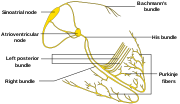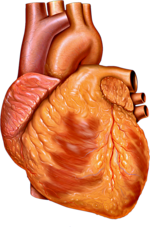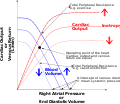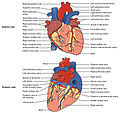Cardiac muscle (also called heart muscle or myocardium) is one of three types of vertebrate muscle tissues, the others being skeletal muscle and smooth...
42 KB (5,130 words) - 05:03, 14 August 2024
skeletal muscle include tendons and perimysium. Smooth and cardiac muscle contract involuntarily, without conscious intervention. These muscle types may...
23 KB (2,579 words) - 22:38, 24 August 2024
smooth, and cardiac (cardiomyocytes). A skeletal muscle cell is long and threadlike with many nuclei and is called a muscle fiber. Muscle cells develop...
37 KB (4,500 words) - 22:16, 12 July 2024
skeletal muscle, the contractions of smooth and cardiac muscles are myogenic (meaning that they are initiated by the smooth or heart muscle cells themselves...
62 KB (7,395 words) - 16:30, 12 July 2024
types of striated muscle: Cardiac muscle (heart muscle) Skeletal muscle (muscle attached to the skeleton) Striated muscle tissue contains T-tubules which...
8 KB (944 words) - 19:41, 19 January 2024
Unlike the action potential in skeletal muscle cells, the cardiac action potential is not initiated by nervous activity. Instead, it arises from a group...
46 KB (5,430 words) - 18:10, 24 April 2024
new "Start" of the cardiac cycle. Throughout the cardiac cycle, blood pressure increases and decreases. The movements of cardiac muscle are coordinated by...
20 KB (1,882 words) - 06:22, 20 August 2024
Muscular system (redirect from Muscle system)
muscular system is an organ system consisting of skeletal, smooth, and cardiac muscle. It permits movement of the body, maintains posture, and circulates...
15 KB (1,733 words) - 15:30, 5 August 2024
propagates through cardiac muscle very rapidly. Cells of the ventricles contract nearly simultaneously. The action potentials of cardiac muscle are unusually...
16 KB (1,840 words) - 02:31, 30 January 2024
of skeletal muscle, cardiac muscle, and smooth muscle such as their actions, structure, size, and location. There are three types of muscle tissue in the...
20 KB (2,285 words) - 17:42, 23 July 2024
Troponin (section Cardiac conditions)
T) that are integral to muscle contraction in skeletal muscle and cardiac muscle, but not smooth muscle. Measurements of cardiac-specific troponins I and...
30 KB (3,653 words) - 03:24, 22 July 2024
of cardiac muscle (heart muscle) in all animals is initiated by electrical impulses known as action potentials that in the heart are known as cardiac action...
11 KB (1,456 words) - 22:27, 11 August 2024
occur at each ventricular systole. Cardiac muscle tissue has autorhythmicity, the unique ability to initiate a cardiac action potential at a fixed rate...
47 KB (5,787 words) - 15:46, 21 August 2024
GLUT4 (section Cardiac muscle)
transporter found primarily in adipose tissues and striated muscle (skeletal and cardiac). The first evidence for this distinct glucose transport protein...
25 KB (2,937 words) - 17:58, 15 January 2024
Smooth (soft) muscle is one of the three major types of vertebrate muscle tissue, the other being skeletal and cardiac muscle. Nonetheless, it is found...
37 KB (4,738 words) - 20:27, 18 July 2024
and others Helleborus spp. (hellebore) Cardiac glycosides affect the sodium-potassium ATPase pump in cardiac muscle cells to alter their function. Normally...
17 KB (1,844 words) - 02:12, 12 May 2024
released directly by nerves that stimulate cardiac muscle cells, have a toxic effect and can lead to decreased cardiac muscular function or "stunning". Further...
52 KB (5,847 words) - 02:57, 26 June 2024
Cardiac amyloidosis is a subcategory of amyloidosis where there is depositing of the protein amyloid in the cardiac muscle and surrounding tissues. Amyloid...
30 KB (3,354 words) - 02:30, 21 June 2024
Troponin I is a cardiac and skeletal muscle protein family. It is a part of the troponin protein complex, where it binds to actin in thin myofilaments...
18 KB (2,156 words) - 03:32, 22 July 2024
Syncytium (section Cardiac muscle)
syncytium of cardiac muscle is important because it allows rapid coordinated contraction of muscles along their entire length. Cardiac action potentials...
18 KB (2,046 words) - 03:47, 22 August 2024
observed in striated muscle, including for example skeletal muscles, arthropod muscle and cardiac (heart) muscle. As striated muscle is stretched, active...
17 KB (1,915 words) - 01:24, 22 June 2024
Cardiac fibrosis commonly refers to the excess deposition of extracellular matrix in the cardiac muscle, but the term may also refer to an abnormal thickening...
25 KB (2,829 words) - 04:49, 23 August 2024
of the cell membrane that penetrate into the center of skeletal and cardiac muscle cells. With membranes that contain large concentrations of ion channels...
25 KB (3,239 words) - 16:16, 6 June 2024
Intercalated disc (category Cardiac anatomy)
Eberth are microscopic identifying features of cardiac muscle. Cardiac muscle consists of individual heart muscle cells (cardiomyocytes) connected by intercalated...
6 KB (548 words) - 15:50, 14 February 2024
Coronary circulation (redirect from Cardiac vessels)
veins that supply the heart muscle (myocardium). Coronary arteries supply oxygenated blood to the heart muscle. Cardiac veins then drain away the blood...
16 KB (1,977 words) - 21:49, 28 November 2023
Arrhythmia (redirect from Cardiac arrhythmias)
impulses in a network of connected excitable elements, specifically in cardiac muscle". Archivos del Instituto de Cardiologia de Mexico. 16 (3): 205–265....
43 KB (4,757 words) - 01:50, 21 May 2024
throughout muscle cells, wrapping around (but not in direct contact with) the myofibrils (contractile units of the cell). Cardiac and skeletal muscle cells...
13 KB (1,810 words) - 15:53, 11 May 2024
Atrial natriuretic peptide (section Cardiac)
increasing renal sodium excretion. ANP is synthesized and secreted by cardiac muscle cells in the walls of the atria in the heart. These cells contain volume...
33 KB (3,952 words) - 19:51, 14 July 2024
Coxsackieviruses to bind to cardiac cells. The natural function of CAR and mechanism that the Coxsackievirus uses to infect the cardiac muscle is still unknown....
59 KB (6,405 words) - 13:45, 21 August 2024























